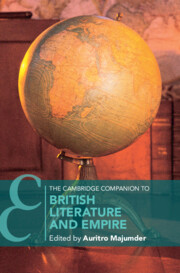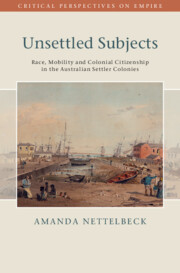Refine search
Actions for selected content:
1413 results
5 - Historical Memory about Slavery, Abolition, and Afro-descendants in the Mexican Press, 1821–60
- from Part II - (Un)Disappearing Black Mexico
-
-
- Book:
- Afro-Mexican Lives in the Long Nineteenth Century
- Published online:
- 20 November 2025
- Print publication:
- 04 December 2025, pp 139-165
-
- Chapter
- Export citation
1 - The Limit of Afro-Mexico
- from Part I - Freedom and Colonial Legacies
-
-
- Book:
- Afro-Mexican Lives in the Long Nineteenth Century
- Published online:
- 20 November 2025
- Print publication:
- 04 December 2025, pp 35-62
-
- Chapter
- Export citation
9 - Gothic Plots and the Nineteenth-Century Irish Novel
- from Part II - Entanglements of Prose, Poetry, and Empire: 1800–1900
-
-
- Book:
- The Cambridge Companion to British Literature and Empire
- Published online:
- 20 November 2025
- Print publication:
- 04 December 2025, pp 136-148
-
- Chapter
- Export citation
2 - Trade, Race, and Class in Early Modern England
- from Part I - Early Intimations and Literary Genres: 1500–1800
-
-
- Book:
- The Cambridge Companion to British Literature and Empire
- Published online:
- 20 November 2025
- Print publication:
- 04 December 2025, pp 36-49
-
- Chapter
- Export citation

The Cambridge Companion to British Literature and Empire
-
- Published online:
- 20 November 2025
- Print publication:
- 04 December 2025

Afro-Mexican Lives in the Long Nineteenth Century
- Slavery, Freedom, and the Writing of History
-
- Published online:
- 20 November 2025
- Print publication:
- 04 December 2025
Conclusion
-
- Book:
- Socialist De-Colony
- Published online:
- 10 November 2025
- Print publication:
- 20 November 2025, pp 266-288
-
- Chapter
-
- You have access
- Open access
- HTML
- Export citation
17 - The Role of Culture
- from Part IV - Realities
-
- Book:
- The Artist's Life
- Published online:
- 04 November 2025
- Print publication:
- 20 November 2025, pp 123-128
-
- Chapter
- Export citation
9 - Equality
- from Part III - Statutory Regulation of the Employment Relationship
-
- Book:
- Labour Law
- Published online:
- 02 October 2025
- Print publication:
- 20 November 2025, pp 329-382
-
- Chapter
- Export citation
3 - Racial Citizenship Moments
- from Part I - Ghana–Soviet Entanglements
-
- Book:
- Socialist De-Colony
- Published online:
- 10 November 2025
- Print publication:
- 20 November 2025, pp 118-162
-
- Chapter
-
- You have access
- Open access
- HTML
- Export citation
1 - “Highlife Solidarity”
- from Part I - Ghana–Soviet Entanglements
-
- Book:
- Socialist De-Colony
- Published online:
- 10 November 2025
- Print publication:
- 20 November 2025, pp 29-79
-
- Chapter
-
- You have access
- Open access
- HTML
- Export citation

Unsettled Subjects
- Race, Mobility and Colonial Citizenship in the Australian Settler Colonies
-
- Published online:
- 13 November 2025
- Print publication:
- 20 November 2025
Race and mental capacity: no panacea
-
- Journal:
- The British Journal of Psychiatry , FirstView
- Published online by Cambridge University Press:
- 13 November 2025, pp. 1-2
-
- Article
-
- You have access
- HTML
- Export citation
12 - Race and Empire
-
-
- Book:
- Explaining the History of American Foreign Relations
- Published online:
- 24 October 2025
- Print publication:
- 13 November 2025, pp 241-262
-
- Chapter
- Export citation
7 - Equality and Non-discrimination
-
- Book:
- The Law and Practice of International Administrative Tribunals
- Published online:
- 27 October 2025
- Print publication:
- 13 November 2025, pp 208-243
-
- Chapter
- Export citation
11 - Race
-
-
- Book:
- Explaining the History of American Foreign Relations
- Published online:
- 24 October 2025
- Print publication:
- 13 November 2025, pp 225-240
-
- Chapter
- Export citation
Parties, Race, and Political Violence: Evaluating Whether Attitudes toward the January 6 Insurrection Vary Across Racial Groups
-
- Journal:
- Journal of Race, Ethnicity and Politics , First View
- Published online by Cambridge University Press:
- 12 November 2025, pp. 1-27
-
- Article
- Export citation

Race, Genetics, History
- New Practices, New Approaches
-
- Published online:
- 11 November 2025
- Print publication:
- 11 December 2025
-
- Element
-
- You have access
- HTML
- Export citation

Socialist De-Colony
- Black and Soviet Entanglements in Ghana's Cold War
-
- Published online:
- 10 November 2025
- Print publication:
- 20 November 2025
-
- Book
-
- You have access
- Open access
- Export citation
Chapter 8 - ‘How to cultivate a love for reading’
- from Part II - Readers and Audiences
-
-
- Book:
- African Literature in Transition
- Published online:
- 23 October 2025
- Print publication:
- 06 November 2025, pp 166-183
-
- Chapter
- Export citation
